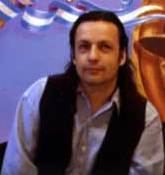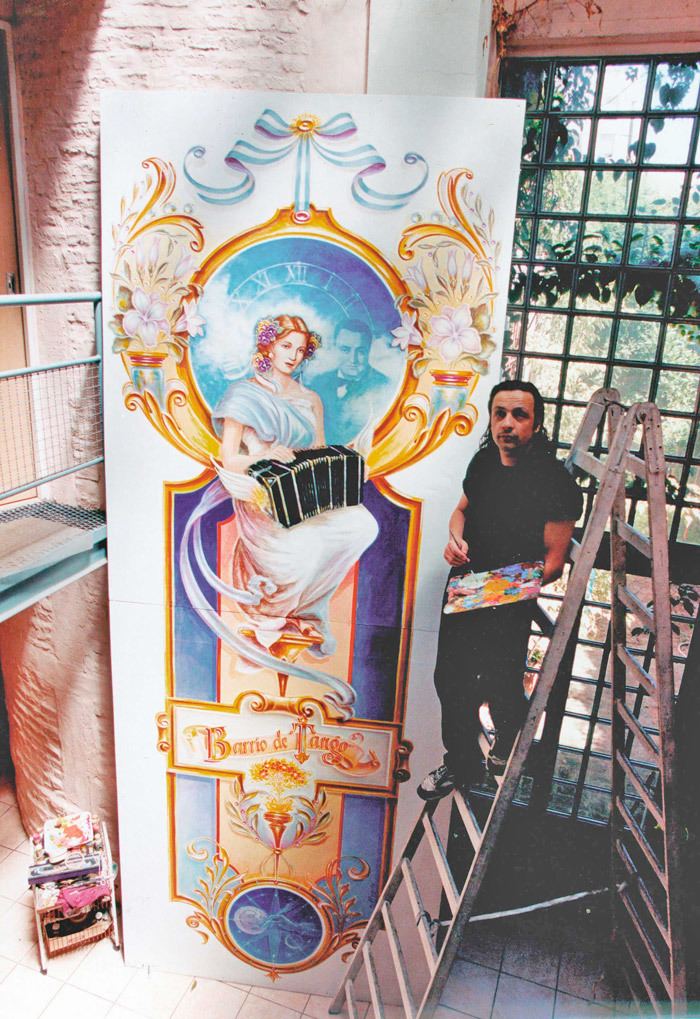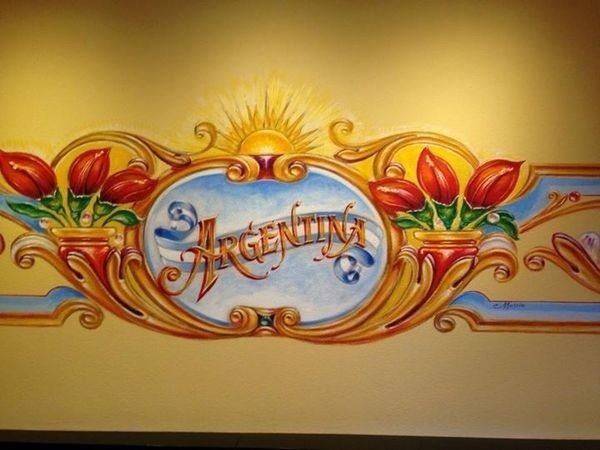Name Jorge Muscia | ||
 | ||
Books El Filete: Popular Art of Buenos Aires | ||
Jorge muscia fileteado porteno
La vida es arte el berni favorito de jorge muscia
Academic Studies

He started studying painting and sculpture in 1976 at the National School of Fine Arts in Argentina, specializing in fileteado porteño (Buenos Aires’ fileteado style) with filete master teacher León Untroib. He also studied diverse international popular arts and ornamental styles, and since 1989 started conducting extensive research in art styles in Italy, Spain, France, England, United States, Mexico, Russia and China.
Contents
- Jorge muscia fileteado porteno
- La vida es arte el berni favorito de jorge muscia
- Academic Studies
- Tango and fileteado
- Teaching and publications
- In the art field
- References
Tango and fileteado

Tango and fileteado are closely related, therefore Muscia participated in several projects where both art forms intersected; he was also a pioneer in integrating the fileteado art into areas in which this type of art had not been seen before. Due to his commendable contribution to Buenos Aires’s popular arts, he was appointed Head Professor at the Academia Nacional del Tango de la República Argentina [Argentina’s National Tango Academy], position which he has continuously held since 1990.
Teaching and publications
In 1995 Muscia publishes "El Filete Porteño, Arte Popular de Buenos Aires", [The filete porteño: Popular Buenos Aires Art ] Spanish-English Edition. This was the first fileteado instruction book published and it was launched simultaneously in Argentina and in The US. This book was sponsored by the Fondo Nacional de las Artes [National Arts Fund] and by the National Tango Academy of the Argentine Republic, and it was declared by the Buenos Aires City Council as a book of cultural relevance. (Regulation 49.554. 1995). Since the 1980s and to this date, Muscia has held seminars, conferences, lectures, demonstrations, exhibits, and has appeared in newspaper articles and TV segments with the purpose of promoting the fileteado art in Argentina and the world. Since 1995 he has been a professor at the Liceo Superior del Tango [Superior Tango Academy] in the course "El Tango y las artes plásticas" [Tango and Plastic Arts].
In the art field
He has presented individual and collective exhibits in Argentina. Since 1984 and sponsored by the Chancellorship of Argentina, he has exhibited his work in art galleries and cultural centers in Europe –London, Berlin, Barcelona, Toulouse, among others, and in Mexico and The US, fact which according to critics has helped to legitimize the fileteado as a means of artistic expression. He has received several awards, including a Scholarship of the Fundacion Antorchas for Artistic Creativity (1992) for his Project Tótems Porteños (Resignificación del Obelisco de Buenos Aires). [Porteño Totem, reinterpretation of the Buenos Aires Obelisc] His works may be found in many prívate collections in Argentina and the world, and in several museums, amongst which we may mention: Museo de la Ciudad [City’s Museum], Museo Manoblanca [Manoblanca Museum], Museo Cultural del Tango [Tango Culture Museum], Museo Mujica Lainez [Mujica Lainez Museum], Museo Agustín Lara [Agustin Lara Museum], Museo Mundial del Tango [World Tango Museum], Mairie de Toulouse Museum, Museo Expo Shanghai [Expo Shanghai Museum], Museo Pallarols [Pallarols Museum], etc. In the last few years he has also done body art painting performances as well as urban art presentations in different parts of the world: Moscow, Paris, Barcelona, Toulouse, Rome, and Shanghai, among other cities. His mural and picture restoration work must also be noted. Amongst others: Cupula of Mother Mary the Savior Church, in La Reja. Buenos Aires Masonic Temple. Coliseo Podestá Theater in the city of La Plata. Argentine Nation Government House. (Pink House) Two murals honoring Discepolo at the Line H, Corrientes Subway Station in Buenos Aires. Ceilings at Pallarols Museum in Buenos Aires. Other important acknowledgements include:
